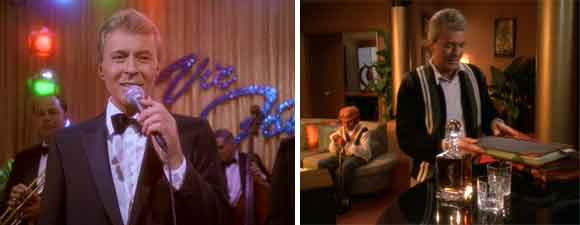Retro Review: By Inferno’s Light
7 min readLed by Gul Dukat, Cardassia joins the Dominion and immediately threatens Bajor and Deep Space Nine.
Plot Summary: Braced for a Dominion attack, Deep Space Nine’s officers are shocked when the fleet ignores them and heads for Cardassian space, followed by Gul Dukat, who announces that Cardassia has joined the Dominion and that he is Cardassia’s leader again. While the Starfleet officers try to figure out who sabotaged the emitters that could have closed the wormhole and prevented the incursion, the Founder who has taken on Bashir’s form sneaks off a station busy with blood screenings and steals a runabout. Meanwhile, the real Bashir is trying to help Garak engineer a damaged transmitter to send a signal to their runabout in orbit, which can beam them out of the Dominion prison where they are being held. But claustrophobia and the trauma of Tain’s death threaten Garak’s sanity, while Worf is forced to fight Jem’Hadar soldiers to demonstrate Klingon strength and honor. Dukat warns Sisko that if the Federation does not join the Dominion, he will retake the station. Desperate for an ally, Sisko convinces Gowron that the Federation and Klingon Empire must stand together against Cardassia and the Dominion, and Gowron agrees to restore their treaty. Though Worf grows increasingly weaker, he insists on fighting every Jem’Hadar challenger until their leader yields, stating that he can kill Worf but not defeat him. The Vorta in charge orders them both killed, but Garak completes his work and beams himself, Worf, Bashir, and Martok off the station just in time. The real Bashir sends a message warning Sisko about the impostor while the Founder Bashir flies toward Bajor’s sun with an explosive capable of making the star supernova, which will destroy Bajor, Deep Space Nine, and all ships nearby – including Dominion and Cardassian ships. Suspecting a trap, Sisko discovers that the Dominion fleet is nowhere near the station and that the sensor ghosts were a ploy to distract him from the explosive. Kira and Dax chase and destroy the stolen runabout, saving Bajor and the station. When Martok arrives with Garak, Bashir, and Worf, Gowron makes the long-lost general the commander of the Klingons on Deep Space Nine. Dukat sends another message, disowning Ziyal for her loyalty to Garak and warning Sisko that he may have survived the solar explosive, but the fight is only beginning.
Analysis: When “By Inferno’s Light” was first broadcast, it wasn’t clear whether this was the beginning of an impending war or yet another false start. As terrible as it sounds to say that I’m glad it was the former – instinctively, I root for patented Star Trek diplomacy, big speeches and the acknowledgment that all people whether they’re silicon-based or shape-shifting have the same basic rights – this was a transformative moment for the series, not one I was sorry to see then or now. The buildup to the Dominion War is usually characterized like U.S. involvement in World War II, when the pivotal event ending our neutrality may have been an attack on our fleet but the underlying reason for direct engagement was an enemy systematically destroying not only our allies but our fundamental commitment to life and liberty. The Dominion arrives bringing the firepower, but it’s Dukat and what he stands for that’s really scary: the brutal oppression of the Bajoran people, tyrannical rule over Cardassia and its allies, violent attacks on anyone who refuses to accept him and his administration. He’s a perfect partner for people who have bred slavishly obedient Vorta and drug-addicted foot soldiers to fight their wars while they isolate themselves far from the struggle. Of course, the real threat from the Founders is not primarily that they can pretend to be anyone and infiltrate anything they like. It’s how the Federation responds to this enemy among them, and in “By Inferno’s Light” we see that that battle has been lost already. When Bashir-who-isn’t-Bashir suggests blood screenings for everyone, no one talks about individual rights; all the senior staff agree that safety is dependent on cooperation. As it turns out, they’re wrong, since the person in charge of the screening is also the person for whom they’re searching, and how he must be gloating to see that he can distract them with anti-Dominion measures considered so odious by so many, particularly since he can sabotage those measures as easily as he can sabotage the emitters. In some ways it looks a lot like post-9/11 America, though “By Inferno’s Light” was written several years earlier.
Interestingly, the Gamma Quadrant story suggests that the Dominion have weaknesses that can be exploited even as the Alpha Quadrant story shows mostly the impotence of Starfleet in dealing with the rising threat. Considering that there’s a massive fleet just waiting to strike, we get little sense that anyone’s locking and loading or looking for a way to perform mass sabotage like the Dominion is doing. There’s a great deal of talking – first Sisko and his senior staff, then Sisko and the Klingons, and even the Romulan arrival is a letdown because we don’t see their warships swooping in looking like the menace they often become. I wish this pivotal episode didn’t feel so much like a bottle show – maybe it’s supposed to mirror Garak’s claustrophobia, but in a strange way it feels like more is happening in the tiny crawlspace where Garak is working than in the power centers of DS9, particularly since Odo never appears in the episode, when one would think he might have been pivotal in unmasking the Bashir changeling. I remember that when I first watched “By Inferno’s Light,” I was bored out of my mind with all the usual Klingon honor crap and thinking that Worf came across less as a paragon than a cliche, but I’ve completely changed my mind about that. Worf’s absolute insistence on being himself, even when Martok was telling him that he’d gone above and beyond what anyone could expect from a Klingon, reveals a crack in what the Dominion perceives as absolute Jem’Hadar loyalty. The First here refuses to obey his Vorta, sparing Worf’s life and recognizing that death and defeat are not the same thing, for which discovery the First is killed, but it’s not the first time we see this conflict between passive Vorta obedience to the laws of the Founders and the Jem’Hadar’s developing sense of themselves as a people who might strive for something more. It’s not clear to me whether Worf keeps fighting because he recognizes that he is having an effect on his enemies or merely because he wants to impress Martok and Garak with his Klingon sense of honor, but it works in both cases, and it’s lovely to see both the cynical Garak and the gruff Martok show their appreciation of this Klingon outsider whom Martok will ultimately bring back into the fold.
There’s not a lot to say in terms of character development apart from Garak’s coming to terms with two great terrors and Bashir’s horror at realizing how easily he can be replaced even in the eyes of his best friend. It’s clear from “In Purgatory’s Shadow” that Tain is the only Cardassian whose goodwill Garak has really cared about; he can handle being an exile from the rest of the planet, even when the Dominion reveal that he is not to be sent home with other Cardassian prisoners, but he is determined to prove himself to his father even now that his father is no longer there to see. That stress only makes his claustrophobia worse, something not even his friendship with Bashir can ameliorate. Poor Bashir has already been replaced by a Changeling once and one has to wonder if there’s a reason they keep picking him besides the need to control the person in charge of blood screenings. Very soon we will discover the reason that not even Bashir’s closest friends know his deepest secrets, but the scene in which O’Brien rolls his eyes a bit as the fake Bashir tries to distract him with darts is very telling, for O’Brien doesn’t have a clue that he hasn’t actually seen Bashir for weeks. No one does. It’s their loss, because the real Bashir is becoming more and more interesting, leaving behind his days of hitting on every attractive woman on the station and trying to impress his elders with his competence. Star Trek’s doctors tend to be pacifists, which I love in McCoy, Crusher, and Pulaski when they’re encouraging temperance in a military environment, but Bashir understands that sometimes the only way to save many lives is to risk a few. Whether it’s Sisko demanding no medical intervention for Bajoran visions that are killing him or Jake looking for understanding in wanting to keep out of a war zone, Bashir’s responses are not terribly predictable, and he’s never passive. The fact that he wants to play darts rather than get in some target practice should be something of a giveaway. It’s strange that the Dominion didn’t more effectively exploit having a duplicate who fit in so well, having him sabotage the sickbay just before he left on his mission to destroy the sun or something similar, but the Dominion threat remains one of shadows – the idea that there could be changelings anywhere is scarier than anything they’d actually done to date.
That, of course, is about to change.







I love this episode – there is just so much quality character showing. Garak, wow! I only wish I could face my own phobia with the courage he shows in the face of his claustrophobia. Worf, of course, is outstanding. In some ways, he is more Klingon than Klingons who grew up on Qo’noS, and in others so non-traditional, but in matters of courage and honour he is the most Klingon character of all. Bashir has finally grown up (well at least the REAL one has, for the most part).
It was definitely time to get the Dominion War started. In real life, I am a pacifist, but in this DS9 universe, it was time to get that line of history in active progress.
I would like to take a moment to shoutout to Igorlex – I got The Stitch in Time, and it was so very much worth the read. I will have to read it again this weekend!! Your book suggestions were excellent, and a couple more should arrive in the next week or two. I am really so interested on where Cardassia goes from there.
“In some ways it looks a lot like post-9/11 America”
Blood screenings suggested by a disguised enemy infiltrator look “a lot like post-9/11 America?” Can you explain how? Some readers don’t have a solid frame of reference for that.
I always enjoy the bits where Michelle talks about how her opinions have changed… either through time, or reflection or just knowing what the rest of the narrative holds. It’s interesting how our opinions can shift over time, and even one episode recorded and static can change in our minds and hearts.
I think it was explained clearly:”When Bashir-who-isn’t-Bashir suggests blood screenings for everyone, no one talks about individual rights; all the senior staff agree that safety is dependent on cooperation.”
The restriction of individual rights (right on privacy, etc…) in name of security.
Dear Ward3, thank you! It’s always great to spread the word about these books. I hope you enjoy McCormack’s vision too 🙂
If you enjoy, I’d really recommend delving into the wider DS9 ‘relaunch’, which is very true to the series it follows. It began with Avatar. Or if you want to read a DS9-style Original Series series, there is Vanguard, starting with Harbinger by David Mack (http://books.google.fr/books?id=QW7gnA8lIBAC&printsec=frontcover#v=onepage&q&f=false)
Anyway, the best place to start asking questions and even talking to the authors is the Treklit section of this site (trekbbs.com/forumdisplay.php?f=43). Hope you enjoy 🙂
You’re saying that voluntary enlistees in Starfleet, etc., have some kind of “individual right” to refuse medical procedures like blood screenings? I think it’s been explained clearly in quite a few episodes that this is not the case; the doctor can force medical checks of any kind, relieve others of their duties as he sees fit, and so on. Attempting to parallel the whole USA to an incident involving a few people in a paramilitary service just doesn’t work.
(I could also challenge you for evidence of some kind of widespread suppression of individual rights in post-9/11 America, but since no such thing took place in practice, let’s actually keep reviews and according comments about the fiction.)
But did those restrictions on individual rights come from a disguised enemy infiltrator? Any evidence for that in USA? That’s all I meant.